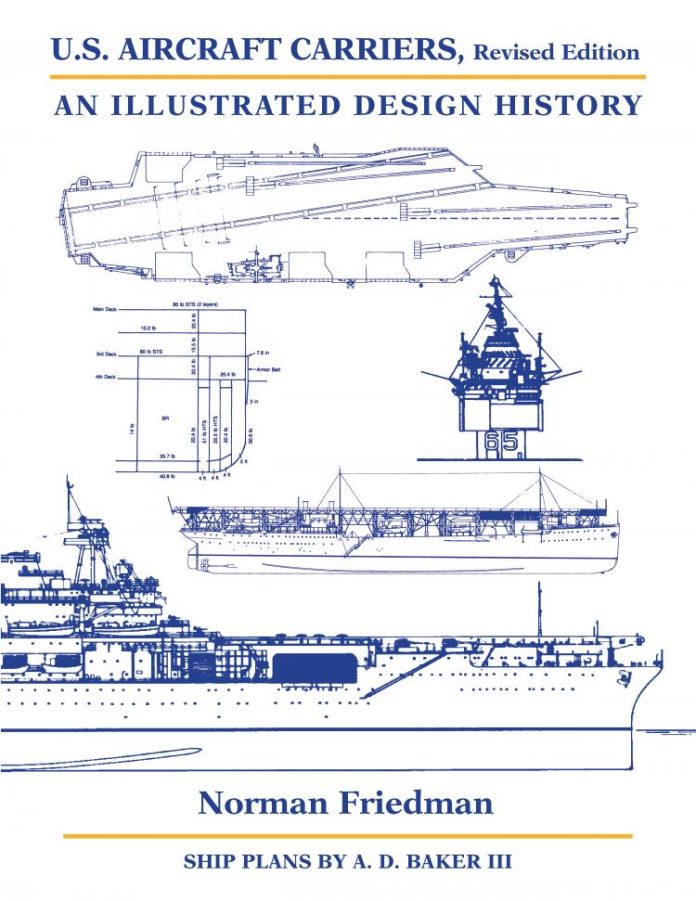
US Aircraft Carriers. An Illustrated Design History. By Norman Friedman. Published by the Naval Institute Press, Annapolis, Maryland in 2022. ISBN 978-1-68247-762-5
Reviewed by David Hobbs
This is an updated edition of a book first published in 1983 and Norman Friedman has used his analytical skill with extensive research to bring the design history of USN carriers up to date. Specifically he describes the changes made to the later ships of the Nimitz class and the upgrades that have been applied all its 10 ships. Photographs complement the description of the USS Gerald R Ford, CVN-78, the first of the latest class but, unlike the previous ships, there is no drawing of her. There is also a brief description of the amphibious carrier USS America, LHA-6, with its enhanced aviation arrangements.
Since the end of the Second World War US Navy aircraft carriers have been the embodiment of American ability to project power around the globe and their movements have generated headlines. The earlier carriers were innovative ships that evolved rapidly and produced the generation of naval aviators who fought the war in the Pacific after the Japanese attack on Pearl Harbor. Friedman’s book is not an operational history recounting the movements of these ships once they entered service but it excels as a detailed account of their design evolution from the initial staff requirement to their eventual construction, completion and subsequent modification. Where there were political arguments about whether carriers should be large or small, or even built at all, these are described in fascinating detail. There are pages of notes in which Friedman writes his sources. These are extensive, informative, in some cases filling half a page, and are worth reading in their own right to add deeper understanding of the subject this books lays before its readers.
It is well illustrated with 323 black and white photographs and 135 drawings including a number of excellent ship plans by A D Baker III. Some of the photographs show structures in close detail so that Friedman can explain the function and use of a wide range of equipment such as radars, satellite communications aerials and weapon systems. Insets to the ship plans show internal arrangements including anti-torpedo protection and armour. Appendices cover carrier designs that were out of the mainstream such as the ships that were used on the Great Lakes to train to train pilots in deck landing techniques. Others cover the design of catapults, arresting gear, the magazine loads of different carrier designs and specific carrier characteristics. Appendix F list every carrier laid down for the USN together with its hull number, builder and, for those no longer in service, their fate.
At first glance one might think that this book deals solely ships that served in the USN but this is not the case. There is RAN interest because a number of the escort carriers described were transferred to the RN under Lend/Lease arrangements from 1942 and Australians served in them. Among these were the then Lieutenant Commander Smith RAN, later Admiral Sir Victor Smith AC KBE CB DSC who was the operations officer in HMS Tracker during 1943/44. This was an escort carrier of the Attacker class, built as BAVG-6 after being laid down as the mercantile Mormacmail. Captain H B Farncombe RAN commanded the escort carrier HMS Attacker in 1944 when she took part in Operation Dragoon, the Allied invasion of Southern France. The name ship of her class, this escort carrier was another Lend/Lease transfer after being built originally as the USS Barnes, ACV-7. The third ship of interest was HMS Biter from the same class, built as BAVG-3 with the original mercantile name Rio Parana. In 1943/44 she served in Western Approaches Command in the Atlantic with 811 Naval Air Squadron embarked which was commanded at the time by Lieutenant Commander E B Morgan RANVR.
For anyone interested in the US Navy, its powerful contemporary carrier strike groups and the background to their design, development and capability enhancement this is an essential book that expands on the information in the first edition whilst retaining its quality. I recommend it highly.



